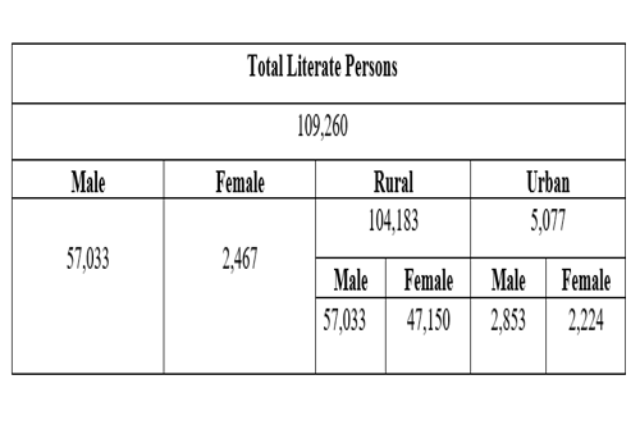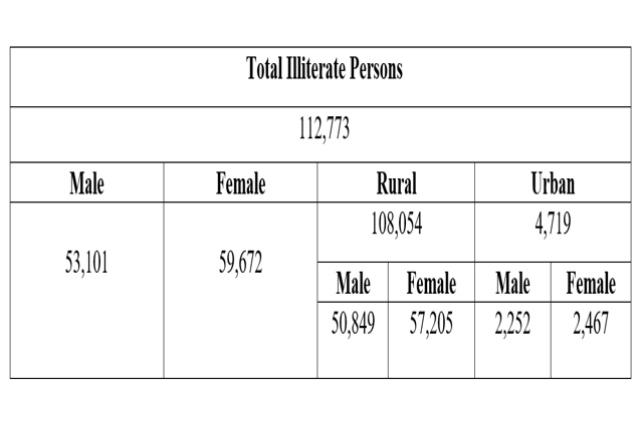
Introduction:
Education is one of the crucial pillars of a society, which’s rate depicts the socio-educational development or backwardness of a community. Swami Vivekananda said that “Education is the manifestation of the perfection already in man”. If the members of a community are educated the socio-condition will be flourished and developed, or vice versa. Murarai II CD Block is located in the Birbhum district of West Bengal. Due to the adolescents’ preferring going out of Bengal for getting engrossed in some lucrative works the educational condition is not so progressed. All the educational facilities are available in the locality of Murarai II whether it is religious or general, but the primary level students is so bad that they neither can utter the Islamic verses unmistakably nor can pronounce the English and other languages clearly. This paper scatters its ray on the brief history of the British Raj over the Bengal.
- Study area: The study area of the researcher is Murarai II CD Block of Birbhum district the 19th district of West Bengal, situated at 24.425833°N 87.960167°E. The area of the Block is 185.33 km2 (71.56 sq mi). This block is surrounded by Suti-I CD Block, in Murshidabad district, on the north, Raghuinathganj-I CD Block in Murshidabad district, in the east, Nalhati-1 and Nalhati-II CD Blocks on the south, and Murarai- I CD Block on the west.
- Objectives: The major objectives of this field research are, (i) to find out the social condition of Muarari II CD Block. (ii) To find out the religious constitute in Murarai II CD Block. (iii) To find out the literacy and illiteracy rate of Murarai II.
A brief history of West Bengal
West Bengal is one of the predominantly Muslim states of India. Having situated in the eastern part of India it's known as West Bengal due to its location considering Bangladesh. This state has a golden past which is chronically proved. Murshid Quli Khan, Alivardi Khan and Sirajuddaulah and others, had flourished in the land of Bengal and had left behind many inheritances and legacies for the upcoming Muslim generations. Many historical places and tourist spots; Hazar Duwari, Motijhil Park, Kathra mosque in Murshidabad, and Adina mosque built by Sikandar Shah in Maldah depict the Bengal as an exotic land of joy and happiness.
This land of Bengal had faced so many brutalities of British rule for about two hundred years. Murshid Quli Khan, Alivardi Khan, and Sirajuddaulah each of them were strong rulers. The British trade made a foray into India and set up East India Company on the banks of the river Hugli and tried to get more privilege in Bengal to extend the trade, for that they asked the Nawab for concessions, but none of them agreed to grant the company concessions. Murshid Quli Khan constantly fought against British power and prevented them from fortification and expanding of British power over the Bengal through trading. Murshid Quli Khan was followed by Alivardi Khan he to fought against them until his death in 1756. Then Sirajuddaulah came to the power and he asked the company to stop interfering in the political affairs of his dominion, stop fortification, and pay the revenues. Sirajuddaulah marched with 30,000 soldiers to the English factory at Kasimbazar, captured the company officials, and locked the trading warehouse. But unfortunately, after the reinforcement of Robert Clive from Madras in 1757 Sirajuddaulah was defeated due to the cheating of his one commander Mir Jafar.
Educational Condition of West Bengal
This block is not so advanced in comparison to Murarai I CD Block, educationally, socially, and economically. The dropout rate from both secondary and senior secondary is high. Students prefer earning money by getting engaged in some daily wage works on going to school. Some of the major find outs of causes for low educational rate is, money problem, for financial support the leave the schools and go to out of state; Chennai, Mumbai, Bangalore, and Calcutta, and get engrossed in some daily works; Rajmistri, factory, and gold shops, etc. Lack of money for tuition, the pressure of family for earning money, sometimes its happen that, some friends are working in a lucrative place or company and making a huge amount of money and having enjoyment, seeing these other friends from school decide to leave the school and get engaged in some lucrative works.
Table 1.1 is depicting the literacy rate of Muslims in West Bengal.
Table- 1.1
Literacy rates of Muslims in West Bengal
| Gender | Muslim's Literacy |
| Male | 64.61 |
| Female | 49.75 |
| Total | 57.47 |
Murarai II CD Block
Murarai-II is a community development block that shapes an administrative division in Rampurhat subdivision of Birbhum district of West Bengal in India. People belonging to different religions and castes are occupying this Block and share diversified cultures and norms among them. As per the Census of India 2011, the total population of Murarai-II CD Block was 222,033.
Table 1.2 is showing the population of Murarai II CD Block based on gender and caste.
Table 1.2
Population of Murarai II
| Rural | Urban | Males | Females | Below 6 Years | SC | ST |
| 212,237 | 9,796 | 112,987 (51%) | 109,046 (49%) | 34,558 | 40,051 (18.04%) | 1,194 (0.54%) |
Murarai-II CD Block is a residence of many religious people, all have freedom to exercise their own ritual and festivals, and worship their God openly. This Block is predominantly Muslim area and Hindu comprises the largest minority.
Table 1.3 is displaying the population and percentage of different religions
Table 1.3
Religions in Murarai II CD Block
| RELIGIONS | POPULATION | PERCENTAGE |
| Muslim | 166,526 | 75.00 |
| Hindu | 55,302 | 24.91 |
| Christian | 114 | 0.06 |
| Others | 61 | 0.03 |
Source: Census Book of India 2011
(District Census Handbook Birbhum)
As this Block is in West Bengal it is perceptibly clear that the most spoken language is Bengali, but along with that people of this Murarai II CD Block are also speaking other languages. To mention a few, such like Hindi, Santali, Kortha/Khotta, Koda/Kora, Telegu and Kurukh/Oraon.
Table 1.4 is showing the percent of languages, being spoken in Murarai II.
Table 1.4
Percentage of languages, spoken in Murarai II CD Block
| LANGUAGES | PERCENTAGE |
| Bengali | 91.9 |
| Sentali | 5.9 |
| Hindi | 1.2 |
| Kortha/Khotta | 0.3 |
| Telegu | 0.2 |
| Koda/Kora | 0.1 |
| Kurukh/Oraon | 0.1 |
Source: Census Book of India 2011
(District Census Handbook Birbhum)
The total area of Murarai II CD Block where it is situated is 185.33 Km2. This block has 1 Panchayat Samiti, 9-gram Panchayats, 87-gram sansads (village councils), 70 mouzas, and 66 residential villages. The headquarters of this block is Paikar and the serving police station is Murarai. The 9-gram Panchayats of this block are: 1) Amdole, 2) Jajigram, 3) Kushmore I, 4) Kushmore II, 5) Mitrapure, 6) Nandigram, 7) Paikar I, 8) Paikar II, and 9) Rudranagar.
Almost all villages of this Block have a population of more than 4000.
Table 1.5 is depicting the village’s list which constitutes up to 4000 population.
Table 1.5
Villages with 4000+ population
| SR. NO. | VILLAGES | POPULATION |
| 1 | MAKHLISPUR | 6,373 |
| 2 | KATHIA | 8,465 |
| 3 | AMDOL | 5,976 |
| 4 | HARIS PUR | 5,128 |
| 5 | JAJIGRAM | 6,977 |
| 6 | KAMARKHUL | 4,598 |
| 7 | PAIKAR | 12,250 |
| 8 | MITRA PUR | 15,452 |
| 9 | DANTURA | 6,870 |
| 10 | BISOR | 5,181 |
| 11 | RUDRANAGAR | 10,756 |
| 12 | DANGHARA | 4,070 |
| 13 | AMUDDA | 4,200 |
| 14 | MATH BASORI | 6,343 |
| 15 | KUTUB PUR | 4,108 |
Literacy and illiteracy rate of Murarai II CD Block
Here comprise many intellectual famous personalities as many illiterate people also. The dropout of students, whether due to delinquency of teachers or financial impediments is causing the low literacy rate.
Table 1.6 is showing the number of literate people of Murarai II.
Table 1.6
Literate person of Murarai II

Table 1.7 is depicting the number of illiterate people of Murarai II.
Table 1.7
Illiterate person of Murarai II

The literacy rate of people is higher than the illiteracy rate. But in comparison to the male, the female comprises less literacy rate. And in the classification of urban and rural, the inhabitants of rural are doing well in educational level.
Conclusion:
In a nutshell, the educational status of Murarai II CD Block is much developed. But regarding the population of villages, so many villages are backward and lagged in education, instead of all facilities. Only 109,260 people are considered literate out of 222,033, while 112,773 people are considered illiterate. The rate can be so higher than its score if the children and youngsters of the community involved themselves in learning and schooling rather than in earning money. If the guardian will stand with their responsibilities of pampering their children in a good and moral process, the children will concentrate on learning and engross themselves in education.
. . .
Bibliography:
- Census Of India 2011 (District census Handbook Birbhum). (2011). Village and Town Wise Primary Census Abstract (PCA) .
- Jyoti Narayan Putra & Prof. Dr. Jayanta Mete. MUSLIMS IN WEST BENGAL: AN INSIGHT INTO THEIR EDUCATIONAL STATUS.. Universitty of Kalyan.
- Social Science, Our Past-III. (December 2017). New Delhi: NCERT Campus, Sri Aourobindo Marg.
- Roy, A. M. (2014). Education Index of Birbhum District at Block Level: A Critical Study . International Research Journal of Social Sciences.
